This post may contain affiliate links. Please read our disclosure policy.
Apricot Kolacky Cookies (kiffles) have flakey cream cheese pastry dough wrapped around an easy apricot filling made from dried apricots! These two-bite cookies are buttery, crisp and addicting.
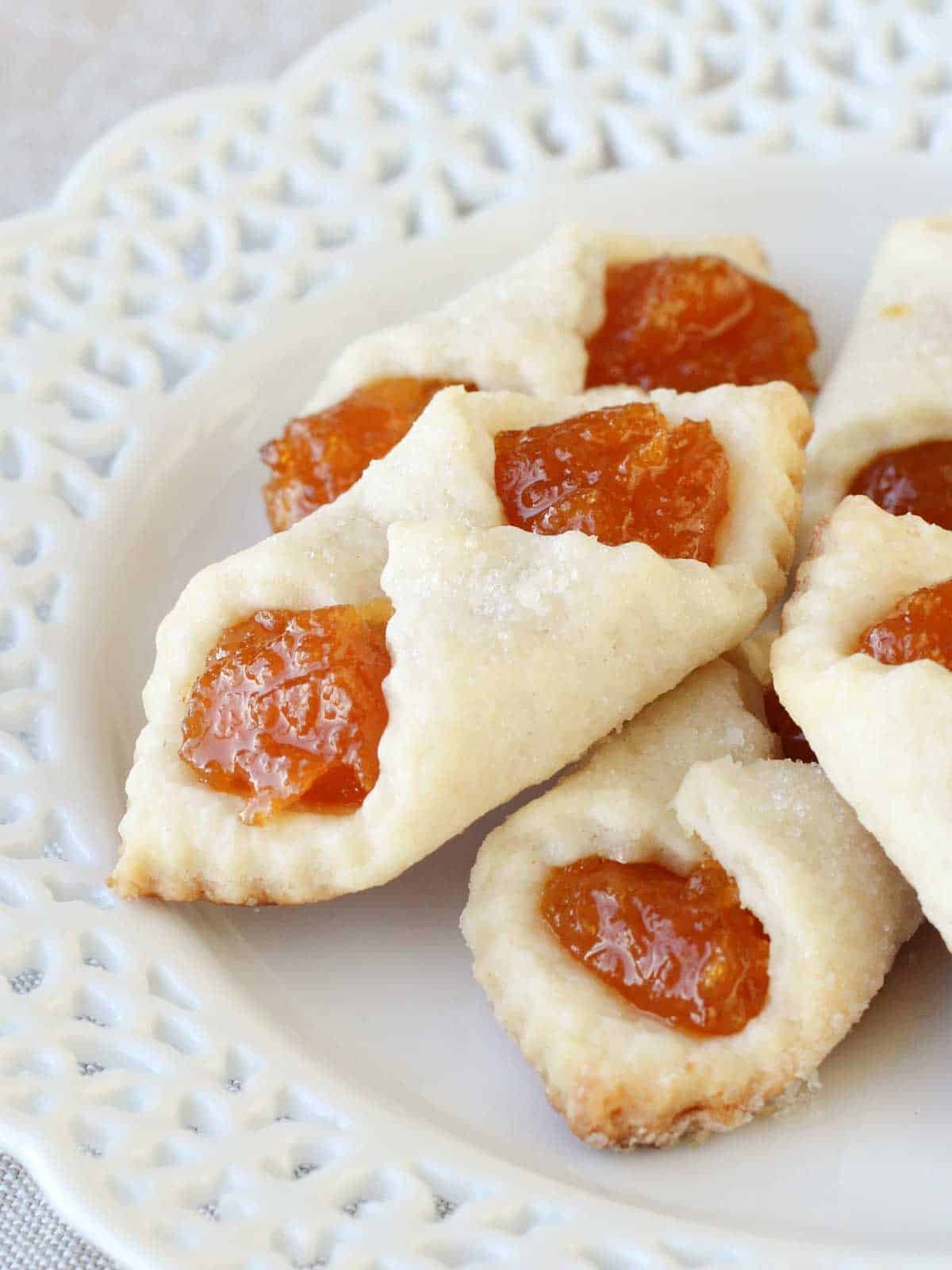
I first posted this kolacky recipe in 2013. I made and remade them until they were perfect! In this post you will find all my tips from back then and new ones I’ve learned as a professional pastry chef.
The cream cheese dough is tender, flakey and just a little bit tangy. There isn’t any sugar in the dough, so rolling it out in sugar adds a bit of sweetness and caramelizes in the oven for extra flavor! It is a technique that I also use in these nut roll cookies!
Table of Contents
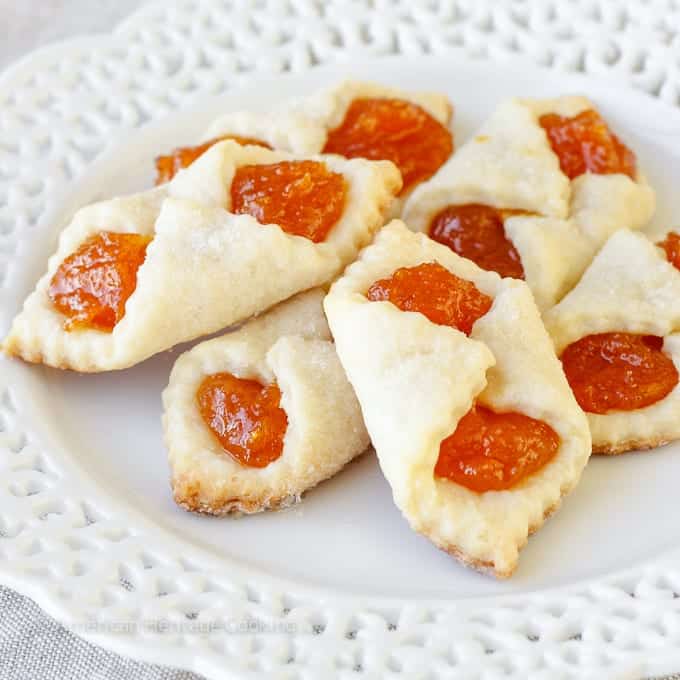

Why you will love these apricot kiffles
- They have an easy crust with cream cheese that can be made in one bowl with a hand mixer. There is no additional moisture, which makes a very rich, tender pastry.
- The homemade apricot filling recipe is made from dried apricots and can be stored in the freezer for future cookie baking! I store mine in plastic piping bags.
- The dough is rolled out in granulated sugar, which creates a caramelized crust on the bottom and a crunchy, sweet coating on top. There is no sugar in the dough, so this is a welcome addition!
What are kolacky?
Kolacky are an Hungarian Christmas cookie. They are typically made with a cream cheese or yeasted pastry dough rolled thin, filled and folded. The most popular fillings are jam, nut filling or poppyseed filling.
Ingredients
- All-purpose flour: All-purpose flour has just the right amount of gluten to make a flakey, tender apricot kolaches.
- Kosher Salt: Kosher salt is lass salty than table salt and a teaspoon weighs less than other finer ground varieties. . It heightens the flavor here and will keep your pastries for tasting dull or flat.
- Cream Cheese: I use original Philadelphia Cream Cheese for all my baked goods. Working the cream cheese into the dough adds fat and a little bit of tang. I’m no stranger to cookies with cream cheese, and I can tell you that cream cheese does not behave the same as butter when baked and will create a soft, tender cookie.
- Butter: I use unsalted butter for baking, because you want to control the amount of salt you are adding. Every brand is different and it makes adjusting the recipe a challenge.
- Granulated Sugar: Rolling out the dough in granulated sugar will add a bit of sweetness and crunch but it will also caramelize on the baking sheet for added complexity of flavor.
- Dried Apricots: I use sulphered dried apricots because they have that beautiful color. Un-sulphered will be dark brown. I use Turkish Apricots because they are plump, sweet and generally have more retained moisture than other varieties.
- Granulated Sugar: Granulated sugar sweetens and thickens the filling. You could reduce it by half and still have success with these cookies. The sweet filling balances the savory pastry for the perfect bite.
Step by step Instructions
The below instructions will give you all the tips you need to make perfect apricot kolacky cookies from the very first time! Additional instructions and measurements can be found in the recipe card below.
Make the apricot filling:
Step 1: Place dried apricots in a small saucepan and pour in just enough water to cover the apricots. Boil until the apricots are soft. Do not let all the water evaporate. Add a little bit more to keep the filling from burning.
Step 2: Add the sugar and continue to cook until thick.
Make sure your filling is thick. Thin jams or fillings will run out of the cookie and burn on the baking sheet.
Step 3: Either puree in a food processor or with an immersion blender in a bowl. If the filling is too runny, return it to the sauce pot to continue to cook.
You can make the filling ahead of time and freeze it until you are ready to use it. Just thaw at room temperature when you are ready to use.
Make the dough:
Step 4: In a large bowl or in the bowl of a stand mixer fitted with the paddle attachment, beat together the cream cheese and butter until completely incorporated and creamy (approximately 3-5 minutes).
Step 5: Reduce the mixer to low and add the salt along with small additions of flour. Adding too much at one time will overwhelm the dough and take too long to mix it. This will create gluten and tough, shrinking cookies! The dough will be soft but not sticky.
Step 6: Divide the dough into 4 equal parts and flatten each to ¾” thick. Wrap in plastic wrap and refrigerate until hard, at least 2 hours.
The dough gets all its moisture from the cream cheese and butter, but you can still overwork it. Divide the dough with a knife or bench scraper rather than tearing it, and press it flat gently. Allow the dough to rest in the refrigerator before rolling or pressing too thin.
Assemble the cookies:
Step 7: Pre-heat the oven to 375°. Move the oven rack one setting higher than the center. Line two baking sheets with parchment paper.
Step 8: Take one of the disks of dough from the refrigerator and lightly flour both sides. Spread granulated sugar on your pastry board or work surface. Place the dough on top and roll out pastry to 1/16” thick or as thin as possible. The thinner the better. If you roll them too thick, the bottom will burn before the inside has a chance to fully cook and puff up.
Step 9: With a pastry wheel or sharp knife, trim the dough into a square and then cut the square into 16 smaller squares. My dough never rolled out into a perfect circle so I would just cut as many 1 1/2 “ squares a possible, saving the scraps for later.
Step 10: Place a dollop of filling in the center of each square. I used ½ teaspoon. Gently grab two opposite corners and fold one over the other, gently pressing down to try and seal them together. Move it to a parchment covered baking sheet, placing the Rolls no closer than 1” apart. You can offset them in a diagonal pattern to get more on a tray. Repeat with all remaining squares.
You can use a little bit of beaten egg or water to seal the corners together. This can help keep them from popping open in the oven.
Step 11: Sprinkle the middles of the rolls with just a touch of granulated sugar. Bake 12-14 minutes or until the bottom edges are a golden and you can smell them. They should puff up slightly in the middle. With experience you can see when the dough is cooked. Let cool slightly on the pan before moving them gently to a wire rack to cool completely.
Chef Lindsey’s Recipe Tip
Don’t chill the assembled cookies prior to baking them. This re-solidifies the butter in the dough and will cause them to puff too much. The extra puff will open the cookies!
The traditional Hungarian apricot filling is from the Paprikas Weiss Traditional Hungarian Cookbook and the cream cheese crust recipe is from June Meyer’s Authentic Hungarian Heirloom Recipes Cookbook with my technique tips.

Substitutions
- Cream Cheese: The cream cheese is the only moisture in this dough, so if you omit it or reduce it, add water to make a cohesive dough. This will change the consistency and texture of the final cookie. Reduced fat cream cheese can be used but not whipped. Be aware that these changes will affect the final results.
- Dried Fruit: You could certainly use a different dried fruit for the filling. You might need to adjust the amount of sugar or water you add in order to get the necessary consistency.
Variations
- Pastry Cutter: Use a fluted or a straight edged cutter for a different look. A fluted cutter makes a ruffled edge that is very festive without any additional work!
- Change the Size: You could make these apricot kiffles larger without much adjustment beyond the bake time. I would not suggest making them smaller, because the smaller the kolaches, the more likely to pop open.
- Change the filling: Apricot, cherry and poppyseed are three of the most popular traditional fillings. You could also make the walnut filling recipe from my Hungarian walnut rolls as well!
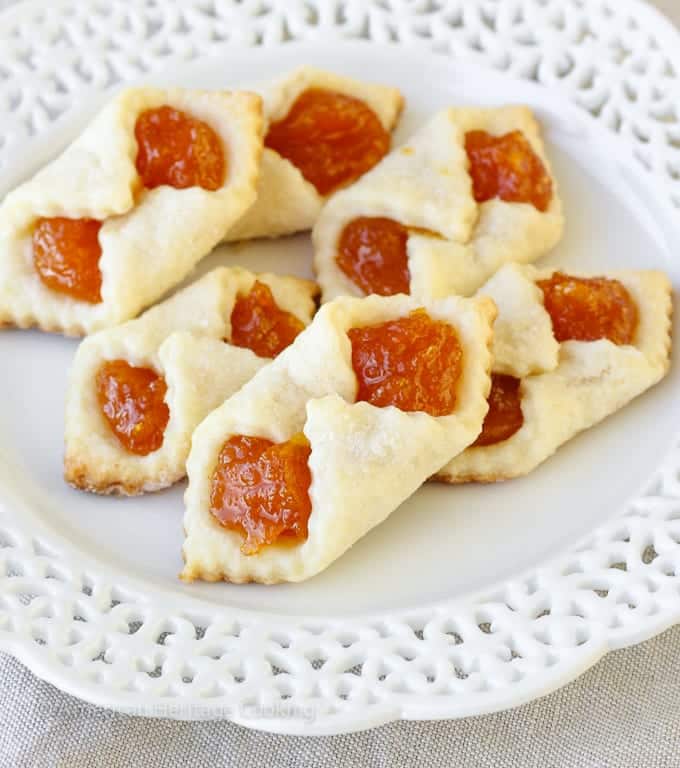
How to store kolacky?
Store baked, cooled cookies at room temperature layered between sheets of wax paper and then wrapped loosely in foil. I found that this will keep them as crisp as possible. You can also freeze them for up to three months.
The raw assembled cookies can also be frozen and then brought to room temperature prior to baking. I suggest freezing in a single layer then placing in a ziptop bag.
Freeze the dough packets and filling separately for later assembly.
Frequently Asked Questions:
Kolacky pop open in the oven when they have too much filling, the dough was chilled before baking, or they are not properly sealed. A firm press to seal should do the trick but others swear by a little bit of water or egg wash. This dough is flakey and if chilled, it will puff excessively like puff pastry in the oven. Sometimes this is desirable, but here we want those cookies to stay shut!
Apricot Kiffles and Apricot Kolaches are a cookie by many names. Multiple Eastern European cultures lay claim to these cookies and they each call them something different. In the Czech Republic and Slovakia kolaches are a type of sweet bread some of which are yeasted. Hungarian kolaches or kolachy are cookies made with a sweet pastry dough and a variety of fillings. In other parts of Eastern Europe and some parts of Hungry call these same cookies apricot kiffles. By any name they are delightful!
Yes! You can freeze fully baked apricot kolaches for up to three months. I layer mine between parchment paper or waxed paper inside a ziptop bag.
This dough is flakey and if chilled, it will puff excessively like puff pastry in the oven. Sometimes this is desirable, but here we want those cookies to stay shut! You do, however, want to chill the dough prior to rolling. This will allow the gluten to relax. It will keep the cookies from shrinking.
If you tried this recipe and loved it please leave a 🌟 star rating and let me know how it goes in the comments below. I love hearing from you; your comments make my day!

Apricot Kolacky Cookie (Kiffles)
Ingredients
For the Pastry:
- 2 ¼ cups all purpose flour
- ½ teaspoon kosher salt
- 8 oz cream cheese
- 1 cup unsalted butter softened
- ½ cup granulated sugar for rolling
For the Apricot Filling:
- 1 lb dried apricots sulfured for color
- 1 cup granulated sugar
Instructions
To make the Apricot Filling:
- Place dried apricots in a small saucepan and pour in just enough water to cover the apricots. Boil until the apricots are soft. Do not let all the water evaporate. Add a little bit more to keep the filling from burning.
- Add the sugar and continue to cook until thick.
- Either puree in a food processor or with an immersion blender in a bowl. If the filling is too runny, return it to the sauce pot to continue to cook.
- You can make the filling ahead of time and freeze it until you are ready to use it. Just thaw at room temperature when you are ready to use.
For the Pastry Dough:
- Whisk flour and salt together in a medium bowl and set aside.
- Beat the cream cheese and butter together with a stand mixer or a hand mixer until completely incorporated and creamy (3-5 minutes).
- Reduce the speed of the mixer and slowly add in the flour. I used 5 additions and completely mixed in the flour each time. The dough will be soft but not sticky.
- Divide the dough into 4 equal parts and flatten each to ¾” thick. Wrap in plastic wrap and refrigerate until hard, at least 2 hours.
Assembling the Kolaches:
- Pre-heat the oven to 375F. Move the oven rack one setting higher than the center.
- Take one of the disks of dough from the refrigerator and lightly flour both sides. Spread granulated sugar on your pastry board or work surface. Place the dough on top and roll out pastry to 1/16” to 1/8” thick. Most recipes say 1/8” but my Husband remembered them being thinner.
- With a pastry wheel or sharp knife, trim the dough into a square and then cut the square into 16 smaller squares. My dough never rolled out into a perfect circle so I would just cut as many 1 1/2 “ squares a possible, saving the scraps for later.
- Place a dollop of filling into the center of each square. I used ½ teaspoon to ¾ teaspoon for each.
- Gently grab two opposite corners and fold one over the other, gently pressing down to try and seal them together. Gently move it to a parchment covered baking sheet. Repeat with all remaining squares.
- Sprinkle the middles of the kolaches with just a touch of granulated sugar.
- Placing the kolaches no closer than 1” apart.
- Bake 12-14 minutes or until the bottom edges are a golden and you can smell them. Let cool slightly on the pan on a wire rack and then move them gently to a wire rack to cool completely.
- Repeat with all remaining dough. Refrigerate and re-roll your scraps. Amazing.
Video
Notes
Nutrition
Before you go!
Check out our other delicious, chef-developed cookie recipes!


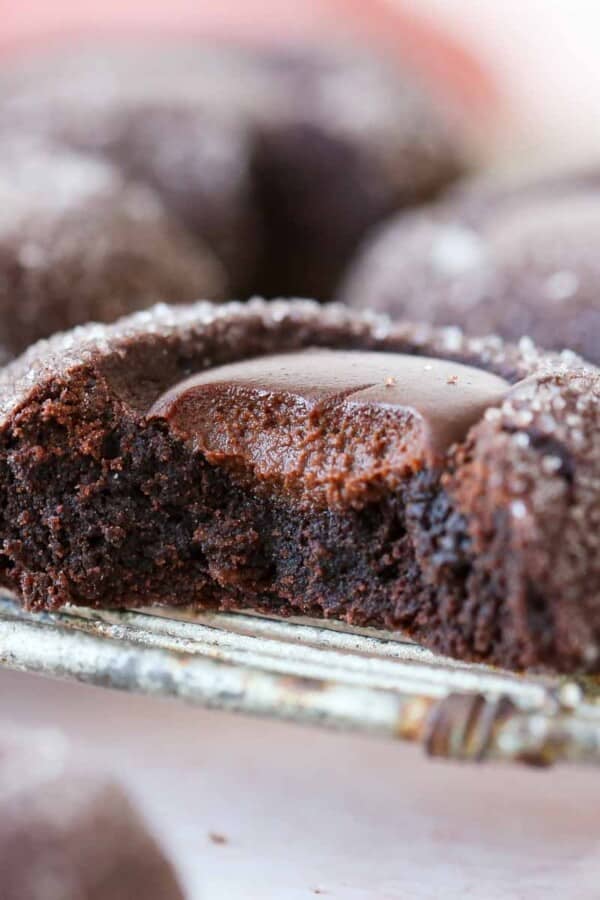
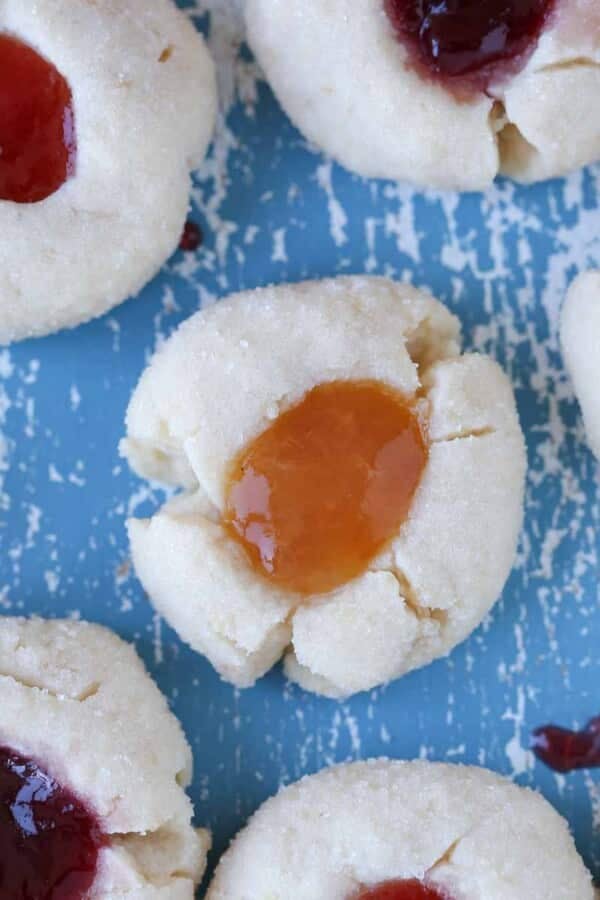










My heritage is Hungarian. Your recipe is similar to my Grandmother and Mom’s recipe for Kiefles. We’ve used Apricot jam (convenience sake) BUT add a little corn starch to the jam to thicken so no running while baking. Just a little FYI for those of us who eat them besides the holiday.
THank you Judy! I eat them all year too 🙂 That’s a great tip about the jam!
Btw kolach is a kinda dough log with poppy walnut or cheese filling. The cheese filling is easy to make but uses farmers cheese not cottage cheese. Cottage is way too watery and just contains sugar n lemon rind along with the juice.
A good substitute for ‘farmer’s cheese’ is to take some cottage cheese drain it and then forced through a sieve/strainer. I do this for a special palacsinta filling I make with the cheese, lemon zest, vanilla, sugar and egg yolk as a binder. YUM.
Interesting technique. That filling sounds delicious. I love the brightness of lemon zest in desserts! Thank you for the tips!
I think maybe helene was going for mag pronounced in hungarian as mug which is translated as seed. More proper for poppy is mak pronounced as mock.
Hi, I just find your side, love it
would you please send me the recipe for kalacs with walnut and mag! possible to my e mail address
thank
Hi Helene! I’m not sure I understand your question. The recipe for the walnut filling is here and I’m not sure what “mag” is? Happy baking!
My mom used to make these twice a year. I just tried and while the baked well the dough (baked kolacky) turned moist after sitting overnight. I used a flour/sugar to roll my dough out and brushed “some” with egg white before baking. Even those without egg white became moist after sitting. Any advice on how to keep this from happening? Thanks, Ed
My grandmother was Hungarian and Russian of Jewish decent and man could she bake and cook. I can remember her making all different flavors of these kolochky pastrys and I want to say thank you for posting you recipe. Most her recipes passed with her and I was way to young then to say “hey write these things down for me”,for when I grow up! So, thank god for the Internet and people like you in it. Happy New Year.
Hi Sheri! That is exactly why I made this and other hungarian recipes in the first place – my husband remembered his grandmother’s cooking and no one had written down the recipes so I started testing out different ones until I arrived at one as good as he remembered! I am overjoyed that you stumbled upon my site and this recipe. Happy New Year, Sheri!
Hi Lindsey,
Your cookies look amazing and I’ve been wanting to try this recipe I just have a few questions.
1. If I make my own filling from raspberries is it ok to use frozen raspberries? I’ve read somewhere that some fillings become too runny in the oven when heated. I’m hoping I can just boil it down with sugar like you did the dried apricots.
2. Can I make the dough a day or two ahead and freeze it? Or will it ruin the flavor and texture? This is actually a general question I have for cookies that have cream cheese in the mixture. Nice tried to research it but have had no luck in getting a clear answer.
3. How about if I assemble them completely with the filling and then freeze them? Or is this a big No No?
4. If I make and bake them completely, let them cool and then freeze them…. Do you think popping them back into the oven from the freezer for a few minutes will crisp them up again or will it just dry it out.
I don’t know if you’ve done any of these things but if you have I would really appreciate some feed back.
Thanks!
Hi Julie! Goodness! I haven’t actually done any of those things but I can definitely weigh in with my opinions.
1. Using fresh fruit is totally different than rehydrating dried fruit like the apricots. You can try cooking down the raspberries with sugar – basically you are making a jam. If you have pectin, that would help. Even if you boil the raspberry filling down until it is very thick, it may still weep in the oven. There is only one way to find out!
2. You can make the dough ahead of time but I wouldn’t freeze it especially if you plan to use it in a day or two. Just make it, wrap it well and refrigerate it. I have frozen chocolate chip cookie dough with cream cheese in it and it was fine, but cream cheese was not a major ingredient like in these kolaches.
3. You can definitely assemble them with the filling and freeze, but I would probably bake them then freeze them because of the cream cheese in the dough and your raspberry filling will probably weep if you freeze it and thaw it. You can freeze cream cheese but the texture changes and I wouldn’t want to risk the integrity of my cookies!
4. Of all of your options, this one is my favorite; however, I wouldn’t put them in the oven directly from the freezer. Let them thaw and then pop them back in the oven for a few minutes. If you put a pre-cooked, frozen cookie in the oven the outside is going to cook too much before the inside has even thawed. So thaw then refresh. Your filling may still weep in this scenario but it is less likely because of the additional bake time.
I hope all of that helps! Happy baking!
HI, I grew up making these, my GM was from Hungary, You can freeze the dough but wrap it carefully. First in parchment paper, then put in a baggie and make sure all the air is out. I then put it in another baggie. This helps keep ice crystals from forming. It does affect the flavor but not much. You can keep it in the fridge for up to a week as long as it is protected from picking up odors and flavors. So maybe freezing isnt necessary. I tried freezing the cookies.. yea that didnt work LOL. I have been making these for over 30 years. A favorite family tradition! Good luck.
Hi Cheryl! Such great tips! I can see freezing the cookies wouldn’t be ideal – mostly from the filling bleeding. What happened? Happy holidays from my family to yours!
Your cookie names are all backwards. This recipe for kolachE is actually a Hungarian Kifli, and the recipe is actually wrong. It’s jr even one of the many variations. Need to rename these and quit calling them authentic.
As I am sure you are aware, there are many variations of every kind of dessert. There is never just one way to make something. Honestly I think your comments are rather rude and uncalled for. I asked the spelling from my Hungarian mother-in-law and my Hungarian husband was the one who taste tested batches of these cookies until they tasted just like his grandmother’s who immigrated to America from Hungary. If Grandma Szabo called kiffle “kolaches” who cares? What is important is that they taste amazing!
This really brings back delicious memories of family holiday gatherings with yummy Hungarian foods. I’m sure that it’s the case that there are regional differences due to the original large territory of Hungary. My family always called them kifle and did use a completely different recipe but yours sound and look equally delicious. I found it interesting that when I went to Budapest the walnut and poppyseed rolls were quite different than the ones made by my relatives who immigrated here!
Hi Catherine! I am so glad they bring back memories for you as they did my husband! Thank you so much for your sweet comment! I hope that I can travel to Budapest some day! Happy holidays!
JL’s comment was rude and sounded too bossy. Thank you Lindsey for your work and for lovingly sharing the fruits of your labor. JL: lighten up. Nothing in this world is perfect …. not even ME! 🙂
LOL. Thanks for the backup Dr. No!
I agree with Dr.No. Theses cookies and their variations are all from Eastern Europe. I am Ukrainian, Russian and Polish decent and we made these same little delites. However I have Americanized mine and I use cherry filling. My family goes wild over them. So with that being said…Kolachky loves unite and bite.
Rude